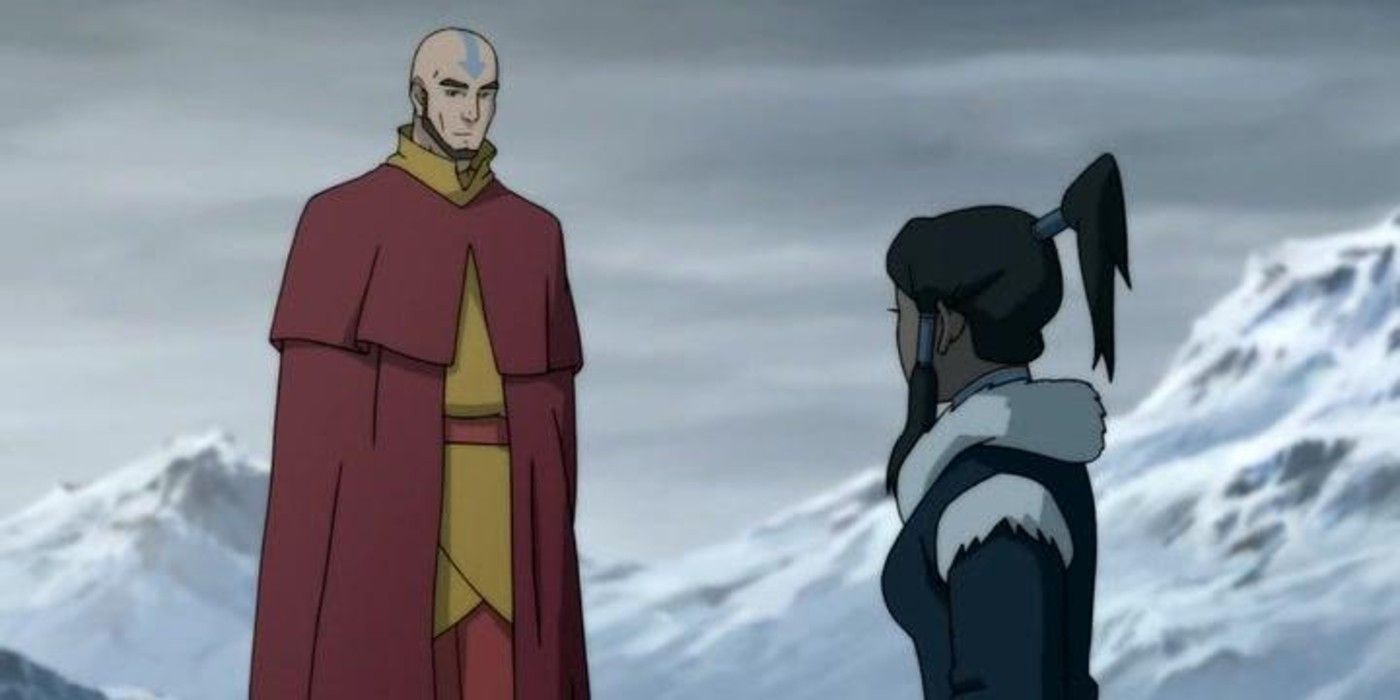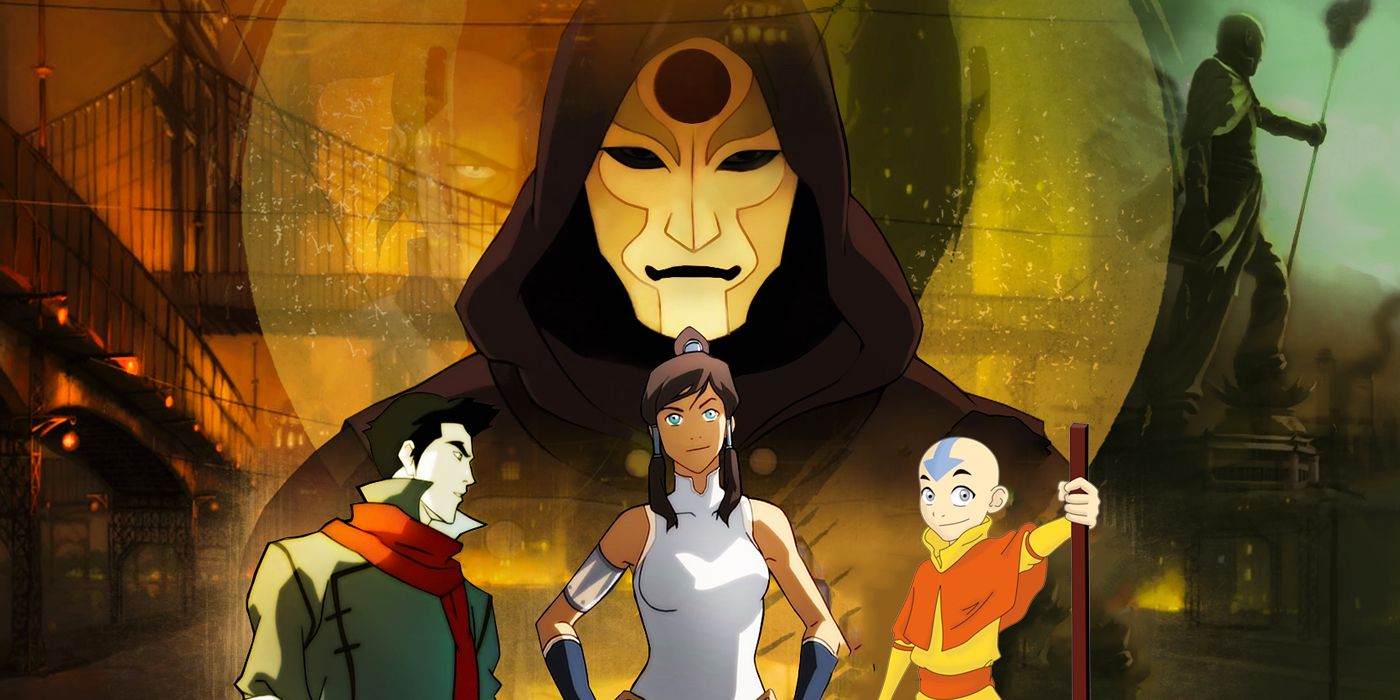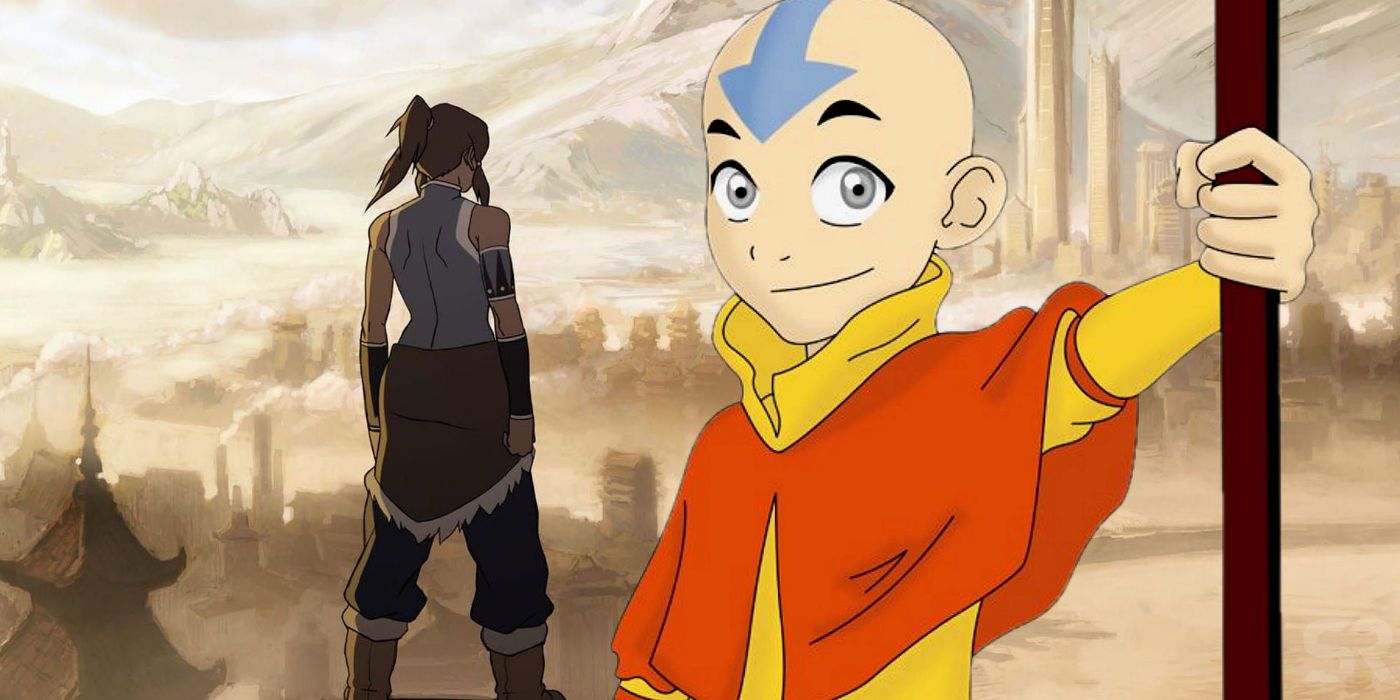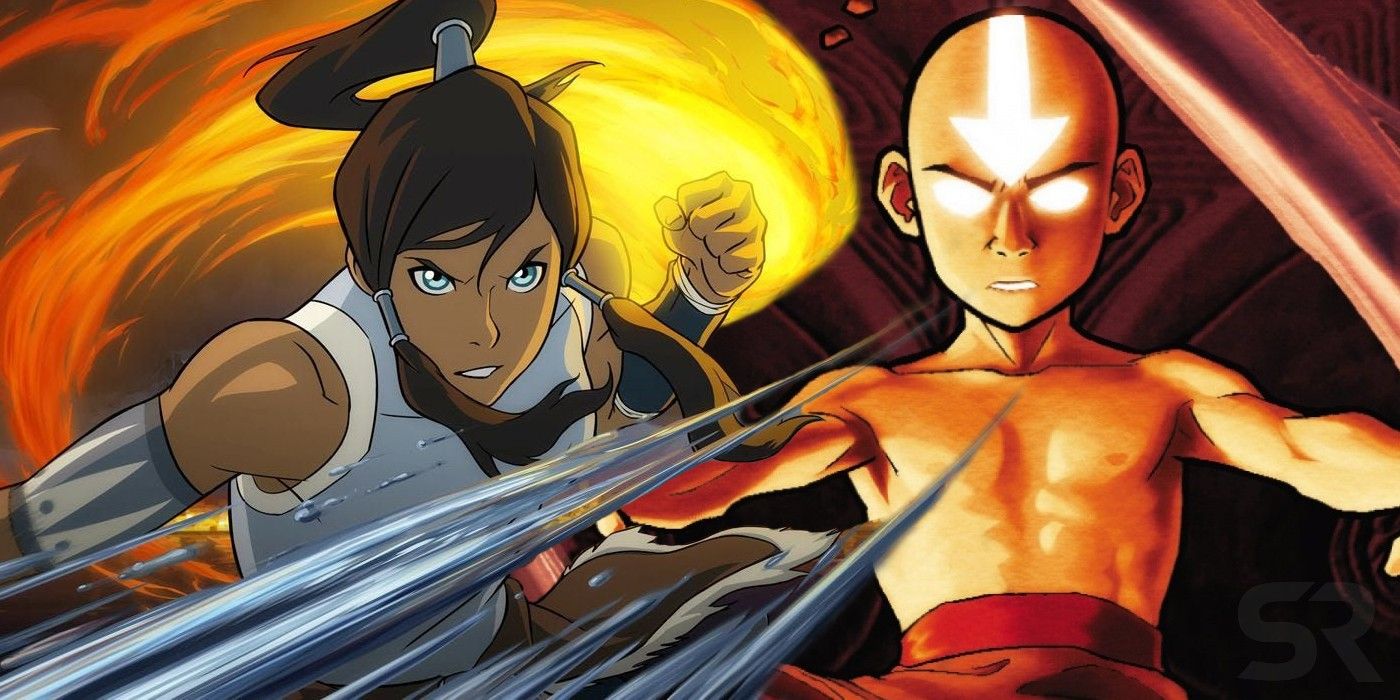In the 70 years that pass between Avatar: The Last Airbender and The Legend of Korra, the world changes dramatically. Technological advances that were stunted by the Hundred Year War explode upon the defeat of Fire Lord Ozai, leading to a mass industrial revolution. Naturally, the challenges of the Avatar in this brave new world are vastly different than those Aang faced during his fight against the Fire Nation, and it’s fitting that Korra is about as different an Avatar as anyone could be.
Korra differs from Aang in the challenges she faces, but also in her very persona and approach to the duties of the Avatar. Where Aang is quiet and pacifist, Korra is blunt and combative. Where Aang excels naturally in the spiritual side of bending, Korra’s greatest strengths lie in her physical abilities as a bender (at least initially). Both Aang and Korra change significantly from their first episode to their last, but just as their inherent natures are different, their journeys to become fully realized Avatars are unique as well.
Of course, there are a number of major similarities between the two as well. Both Aang and Korra become aware of their identity at a particularly young age. Traditionally, the Avatar is informed of their identity at the age of 16, but Aang is told at 12, and Korra learns even earlier. Similarly, Aang and Korra both show exceptional bending prowess very early on in life, with Korra able to bend three elements as a young child, and Aang being the youngest airbender in history to receive his master’s tattoos, until his granddaughter Jinora. And of course, both Aang and Korra are fiercely loyal to their friends, dedicated to the responsibilities of the Avatar, and completely devoted to their animal companions.
While many comparisons between Aang and Korra focus on who is the better Avatar or the stronger bender, their relationship is more complex. Looking at their personalities and abilities is important, but to get a complete picture of both Avatars and how they differ, it’s also necessary to look at the differences in their challenges, and in their approaches to those challenges.

This distinction is critical to understanding the differences between Aang and Korra. In Korra’s own words, “All I ever wanted to be was the Avatar.” In Aang’s words, “I never wanted to be.” The fact is, Aang comes into a world that desperately needs the Avatar in a very overt way, while the world in Korra’s time seems dedicated to proving that the Avatar is irrelevant. This makes Aang and Korra’s arcs almost mirrors of each other: Aang has to learn how to accept his identity as the Avatar when “the world needed him most,” while Korra has to figure out how to be the Avatar in a world that seems to be moving beyond her.
From an incredibly young age, Korra prepares herself for her role as the Avatar. However, that role doesn’t turn out to be exactly what she plans. In this new modern age, where mass media and democratic elections exist, she’s subject a much higher scrutiny than Aang or any other Avatar before. The Avatar was always famous, but Korra is the first to truly become a celebrity, complete with press conferences, radio interviews, and approval ratings.
This is not the kind of Avatar that Korra was trained to be. She was raised in isolation by an ancient group of spiritual leaders to be the same kind of hero that Aang was, only to find out that the world doesn’t need that kind of Avatar anymore (or at least, it doesn’t think it does). By contrast, Aang never receives any formal Avatar training at all, save for a few weeks with the high monks of the Southern Temple. But his mission as the Avatar is always clear – defeat Ozai and restore peace. His primary challenge is in preparing himself for a role that he never really wanted. Korra’s challenge is in accepting that the role she was trained for is not the one she must perform.

This is the most common point of comparison between the two Avatars. Aang is an airbender through-and-through. It colors his personality and his approach to every challenge he faces. Even after learning all the other elements, airbending remains his signature in combat – even though it is less effective as an offensive technique than the others. This is because Aang rarely fights strictly for offense. He wins by being “quick or clever,” in his own words, and this even holds true in his final confrontation with Ozai. And like all Air Nomads, he's strictly vegetarian.
By contrast, Korra struggles immensely with airbending. She may look like a waterbender, but she has the soul of a firebender. It’s no mistake that the first real display of her bending talent shown in The Legend of Korra is her final firebending trial. That fight shows exactly who she is: a cocky, flamboyant, physically aggressive fighter with incredible strength. Firebending is her go-to combat form for much of the show, and even after significant time training as an airbender, she still throws air like a firebender. She also becomes a skilled metalbender later in the show, a skill Aang was never capable of - possibly due to his struggles with the disciplines of earthbending.
And of course, Korra’s aggressive persona is more than just an inclination towards fighting. She kicks down doors. She avoids politeness. She often threatens physical violence. These more bullheaded tendencies are often seen as the core of Korra, but it’s also important to note that her overarching story is one about overcoming those more brash instincts. She remains bold, confident, a bit of a jock at heart, but she also becomes more reserved and considerate, more delicate in her approach to situations, and more sensitive to nuance. So while she is certainly a more confrontational person than Aang, it’s incomplete to write her off as stubborn and always looking for a fight.

As mentioned before, Aang’s task of defeating the Fire Lord is much simpler than the complicated political conflict that Korra has to deal with. That doesn’t mean that Aang has an easier job, but it does mean that his end-goal can be summed up in one word: peace. Even outside of the war, he generally prioritizes peace over balance. While the two are closely related, they are not the same. This is shown early on in season 1 of Avatar: The Last Airbender, in the often-mocked-as-filler episode “The Great Divide.” At the end of the episode, Aang resolves the conflict between two rival Earth Kingdom tribes by claiming to have been present at the historical moment when their feud began. He explains that the story is misremembered, and that there’s really no reason for the animosity between the tribes to exist.
But he was lying. Aang makes the story up completely to broker a peace that is built on falsehood. Is he wrong to do so? Not necessarily. But his preference for avoiding conflict plays into his broader choices as the Avatar, and not always in the best way. In the graphic novel The Rift, which takes place after the end of the Avatar: The Last Airbender, Aang struggles to find balance between a group of human industrialists and an ancient spirit angered by the factory they’ve built, on land that will become the United Republic. Aang ultimately kills the spirit – albeit primarily to save Toph – and though another spirit assures him that balance will still be maintained on the land, the state of the spirits in The Legend of Korra seem to suggest this isn’t true.
While Korra struggles early on to tap into her spiritual energy, her decisions ultimately prioritize long-term balance over peace. No villain is written off in The Legend of Korra, and she herself incorporates elements of their philosophies into her own. Korra’s decision to keep the spirit portals open helps to rebalance the world by restoring the power of airbending and reconnecting humans and spirits. This decision, however, is far from peaceful. Korra is literally run out of Republic City over the presence of the spirit vines because the public outcry against her choice is so strong.
At the end of The Legend of Korra, the world is not necessarily more peaceful than it was at the beginning. The Earth Kingdom remains in fragmented pieces, stricken by poverty and the still-present scars of a century-long war. Humans and spirits still struggle to find an effective coexistence, even into the graphic novels. But the choices Korra makes are steps toward a more lasting balance, and she understands that balance may not mean immediate peace for everyone; that change inevitably means some things are lost.

Avatar: The Last Airbender is a show about hope. It’s a show about how people can give each other hope, and how cooperation for good can give the world hope. Aang is a living embodiment of that idea. He represent the hope of the world that the war might end, that good can triumph over evil, and that the Air Nation might come back. He gives Zuko hope that he can redeem himself. He gives the Water Tribe hope that it can withstand and rebuild. After the conquest of Ba Sing Se, his survival gives hope that the war is not yet lost. This idea can be clearly seen in episodes like "Imprisoned," "The Serpent’s Pass," "The Blue Spirit," and "The Day of Black Sun." It’s one of the main thematic cruxes of the show, and Aang is at its center.
The Legend of Korra is a show about change. It’s a show about how - as one particular proverb from season 3 puts it – “New growth cannot exist without first the destruction of the old.” While many say that Korra has no overarching story, the real overarching story is the movement of the world from a pre-modern world to a modern world, and all the growing pains that come with that – capitalistic corruption, industrialism, environmental destruction, emergent political systems, etc.
While Aang’s story is about learning, Korra’s story is about changing. Where Aang heals the world, Korra changes the world. The biggest instance of this is of course her reopening of the spirit portals, but her season 4 arc is also about change. Specifically, it’s about learning to deal with the change that results from traumatic events. Season 4 parallels Korra processing the trauma inflicted on her by Zaheer with the Earth Kingdom processing the trauma inflicted on it by the war and the subsequent economic fallout. Korra learns that change is inevitable, that it’s necessary to achieve balance, and that it can be restorative as well as painful.
The destruction of Korra’s connection to her past lives at the end of season 2 is one of the most controversial moments in the entire show, but it’s also one of the most significant moments for her arc of accepting change. And ultimately, because or in spite of it, she comes back a wiser Avatar afterwards. Ultimately, a lot can be learned from both Aang and Korra, in large part because of their differences. Watching them both find their own unique solutions to their own unique challenges is part of what makes both Avatar: The Last Airbender and The Legend of Korra so rewarding to watch.
from ScreenRant - Feed https://ift.tt/2QkN3Bm
via IFTTT








0 comments:
Post a Comment